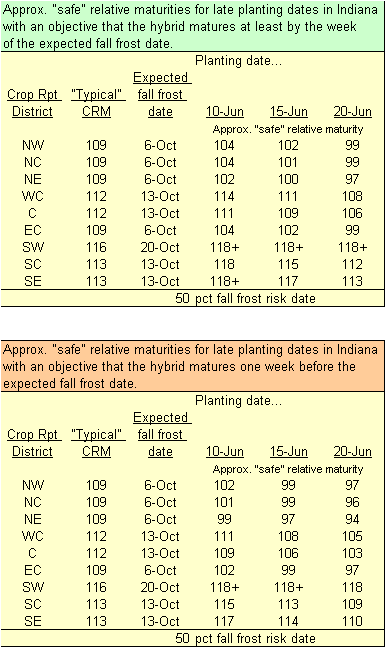Published 7 June 2010
URL: http://www.kingcorn.org/news/articles.10/SafeHybridMaturities-0607.html

The Crop Reporting Districts are those defined by the National Ag.
Statistics Service, USDA, for Indiana.
The acronym “CRM” refers to
Comparative Relative Maturity as defined by Pioneer Hi-Bred.
"Safe" Hybrid Maturities for Late Corn Planting in Indiana
R.L. (Bob) Nielsen
Agronomy Dept., Purdue Univ.
West Lafayette, IN 47907-2054
Email address: rnielsen
at purdue.edu
Some Indiana crop producers may yet be wanting to plant "first crop" corn acres or are facing possible late replant situations. Such late plantings are obviously not favorable for optimum corn yields, but some growers have their reasons for sticking with corn planting at this time of the season. One of the biggest concerns with late planting is the risk of the crop not reaching physiological maturity before a killing fall freeze and so folks need to be substituting earlier hybrid maturities for later ones by this of the year.
The tables that accompany this article list "safe" relative hybrid maturities for corn planted as late as June 10, 15, and 20 based on their heat unit requirements (adjusted for planting date) and anticipated "normal" accumulation of heat units between planting and an average date (50% probability) of a killing fall freeze. It should be no surprise that changes in hybrid maturity decisions are most evident for late planting in the northern and central areas of Indiana.
The maturities listed in the first table are those that should reach physiological maturity at least by the week when a killing fall freeze occurs, while the second table lists hybrid maturities that should mature at least by the week PRIOR to a killing fall freeze. When making a decision to plant corn this late with hybrid maturities that are unusually early for your area of the state, make the effort to identify hybrids with good disease resistance traits.
Recognize that while the hybrid maturities listed in either table should safely mature by their respective dates, they will mature at a time in the fall when further grain drying in the field typically occurs at a proverbial snail's pace. Thus, grain moisture at harvest may be unacceptably high in terms of both the ease of harvest and the costs of artificially drying the grain.
Related References
Nielsen, Bob. 2002 (rev). Estimating Yield and Dollar Returns From Corn Replanting. Purdue Univ. Cooperative Extension Service publication AY-264-W. Online at http://www.agry.purdue.edu/ext/pubs/AY-264-W.pdf. [URL accessed June 2010].
Nielsen, R.L. (Bob). 2009. Interpreting Corn Hybrid Maturity Ratings. Corny News Network, Purdue Univ. [online] http://www.kingcorn.org/news/timeless/HybridMaturity.html [URL accessed June 2010].
Nielsen, R.L. (Bob) and Peter Thomison. 2003. Delayed Planting & Hybrid Maturity Decisions. Purdue Univ. Cooperative Extension Publication AY-312-W. [On-line]. Available at http://www.agry.purdue.edu/ext/pubs/AY-312-W.pdf [URL accessed June 2010].
Nielsen, Robert L., Peter R. Thomison, Gregory A. Brown, Anthony L. Halter, Jason Wells, and Kirby L. Wuethrich. 2002. Delayed Planting Effects on Flowering and Grain Maturation of Dent Corn. Agron. J. 94:549-558.

